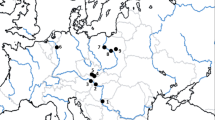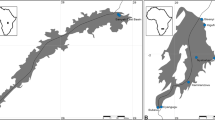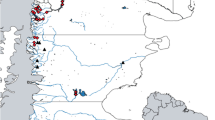Abstract
Gyrodactylid monogeneans are considered to be the most invasive fish parasites. They are omnipresent on teleost fishes and host change might play a crucial role in their biology. In the present study, related fish species were kept in single- or mixed-species groups to test the ability of Gyrodactylus species to change their host fish under experimental conditions. The first group included two percid fish species, perch Perca fluviatilis L. and ruffe Gymnocephalus cernuus (L.), and the second group two cyprinid species, roach Rutilus rutilus (L.) and minnow Phoxinus phoxinus (L.). A total of 4,182 specimens of 19 monogenean species belonging to five genera were observed, and eight species of Gyrodactylus were identified. There were three species of Gyrodactylus found on roach and six species on minnow. Gyrodactylus vimbi parasitized both cyprinid fish species and was the only species that increased in intensity during the experiments and also assumed to transmit from minnow to roach, while the other recorded host change case, Gyrodactylus macronychus, was represented by a single individual that transmitted from minnow to roach. Gyrodactylus rutilensis and Gyrodactylus pannonicus remained on their original hosts (roach and minnow, respectively). Gyrodactylus cernuae was the only species observed on both ruffe and perch, but ruffe appeared more susceptible to this parasite. Most of the gyrodactylids observed on roach and minnow were situated on the fins, while gyrodactylids of perch and ruffe parasitized mainly the gill chamber and head.

Similar content being viewed by others
References
Aaltonen TM, Jokinen EI, Valtonen ET (1994) Antibody-synthesis in roach (Rutilus rutilus)—analysis of antibody-secreting cells in lymphoid organs with ELISPOT-assay. Fish Shellfish Immun 4(2):129–140
Andersen PS, Buchmann K (1998) Temperature dependent population growth of Gyrodactylus derjavini on rainbow trout, Onchorhynchus mykiss. J Helminthol 72:9–14
Bakke TA, Sharp LA (1990) Susceptibility and resistance of minnow, Phoxinus phoxinus (L.) to Gyrodactylus salaris Malmberg, 1957 (Monogenea) under laboratory conditions. Fauna Norv Ser A 11:51–55
Bakke TA, Jansen PA, Brabrand A (1990) Susceptibility and resistance of brook lamprey, Lampetra planeri (Bloch), roach, Rutilus rutilus (L.) and perch, Perca fluviatilis L. to Gyrodactylus salaris Malmberg (Monogenea). Fauna Norv Ser A 11:23–26
Bakke TA, Jansen PA, Hansen LP (1991) Experimental transmission of Gyrodactylus salaris Malmberg, 1957 (Platyhelminthes, Monogenea) from the Atlantic salmon (Salmo salar) to the European eel (Anguilla anguilla). Can J Zool 69:733–737
Bakke TA, Harris PD, Jansen PA, Hansen LP (1992) Host specificity and dispersal strategy in gyrodactylid monogeneans, with particular reference to Gyrodactylus salaris (Platyhelminthes, Monogenea). Dis Aquat Organ 13:63–74
Bakke TA, Harris PD, Cable J (2002) Host specificity dynamics: observation on gyrodactylid monogeneans. Int J Parasitol 32:281–308
Boeger WA, Kritsky DC, Pie MR, Engers KB (2005) Mode of transmission, host switching, and escape from the red queen by viviparous gyrodactylids (Monogenoidea). J Parasitol 91(5):1000–1007
Buchmann K, Uldal A (1997) Gyrodactylus derjavini infections in four salmonids: comparative host susceptibility and site selection of parasites. Dis Aquat Organ 28(3):201–209
Buchmann K, Lindenstrøm T (2002) Interactions between monogenean parasites and their fish hosts. Int J Parasitol 32:309–319
Bush AO, Lafferty KD, Lotz JM, Shostak AW (1997) Parasitology meets ecology on its own terms: Margolis et al. revised. J Parasitol 83:575–583
Cable J, van Oosterhout C, Barson N, Harris PD (2005) Gyrodactylus pictae n. sp. (Monogenea: Gyrodactylidae) from the Trinidadian swamp guppy Poecilia picta Regan, with a discussion on species of Gyrodactylus von Nordmann, 1832 and their poecilid hosts. Syst Parasitol 60:159–164
Cunningham CO, McGillivray DM, MacKenzie K, Melvin WT (1995) Discrimination between Gyrodactylus salaris, G. derjavini and G. truttae (Platyhelminthes: Monogenea) using restriction fragment length polymorphisms and an oligonucleotide probe within the small subunit ribosomal RNA gene. Parasitology 111:87–94
Gelnar M (1990) Experimental verification of the water temperature effect on the micropopulation growth of Gyrodatylus rutilensis Glaser, 1974 (Monogenea). Folia Parasit 37(2):113–114
Glaser HJ (1974) Sechs neue Arten der Gyrodactylus wageneri Gruppe (Monogenea, Gyrodactylidae) nebst Bemerkungen zur Preparation, Determination, Terminologie und Wirtsspezifisitat. Zool Anz 192:56–76
Gussev AV (1985) Monogenea. In: Bauer ON (ed) Identification key to parasites of fresh-water fishes (in Russian), Part 2. Nauka, Leningrad
Harris PD (1988) Changes in site specificity of Gyrodactylus turnbulli Harris, 1986 (Monogenea) during infection of individual guppies (Poecilia reticulata Peters, 1859). Can J Zool 66:2854–2857
Harris PD (1993) Interactions between reproduction and population biology in gyrodactylid monogeneans—a review. B Fr Peche Piscic 328:47–65
Harris PD, Soleng A, Bakke TA (2000) Increased susceptibility of salmonids to the monogenean Gyrodactylus salaris following administration of hydrocortisone acetate. Parasitology 120(1):57–64
Harris PD, Shin AP, Cable J, Bakke TA (2004) Nominal species of the genus Gyrodactylus von Nordmann 1832 (Monogenea: Gyrodactylidae), with a list of principal host species. Syst Parasitol 59(1):1–27
Jansen PA, Bakke TA (1991) Temperature-dependent reproduction and survival of Gyrodactylus salaris Malmberg, 1957 (Platyhelminthes: Monogenea) on Atlantic salmon (Salmo salar L.). Parasitology 102:105–112
Kearn GC (1994) Evolutionary expansion of the Monogenea. Int J Parasitol 24(8):1227–1271
Kennedy CR (1975) Ecological animal parasitology. Blackwell, Oxford
King TA, Cable J (2007) Experimental infections of the monogenean Gyrodactylus turnbulli indicate that it is not a strict specialist. Int J Parasitol 37:663–672
Koskivaara M, Valtonen ET, Prost M (1991a) Seasonal occurrence of gyrodactylid monogeneans on the roach (Rutilus rutilus) and variation between four lakes of differing water quality in Finland. Aqua Fennica 21(1):47–55
Koskivaara M, Valtonen ET, Prost M (1991b) Dactylogyrids on the gills of roach in central Finland—features of infection and species composition. Int J Parasitol 21(5):565–572
Lymbery AJ (1989) Host specificity, host range and host preference. Parasitol Today 5(9):298–298
Malmberg G (1970) The excretory systems and the marginal hooks as a basis for the systematics of Gyrodactylus (Trematoda, Monogenea). Ark Zool 23:1–235
Matějusová I, Gelnar M, McBeath AJA, Collins CM, Cunningham CO (2001) Molecular markers for gyrodactylids (Gyrodactylidae: Monogenea) from five fish families (Teleostei). Int J Parasitol 31:738–745
Mills CA, Eloranta A (1985) The biology of Phoxinus phoxinus (L.) and other littoral zone fishes in Lake Konnevesi, central Finland. Ann Zool Fenn 22:1–12
Mo TA (1997) Seasonal occurrence of Gyrodactylus derjavini (Monogenea) on brown trout, Salmo trutta, and Atlantic salmon, Salmo salar, in the Sandvikselva River, Norway. J Parasitol 83(6):1025–1029
Moen DS, Stockwell CA (2006) Specificity of the monogenean Gyrodactylus tularosae Kritsky and Stockwell, 2005, to its natural host, the white sands pupfish (Cyprinodon tularosa Miller and Echelle 1975). Comp Parasitol 73(2):278–281
Olstad K, Robertsen G, Bachmann L, Bakke TA (2007) Variation in host preference within Gyrodactylus salaris (Monogenea): an experimental approach. Parasitology 134:589–597
Poulin R (1992) Determinants of host-specificity in parasites of freshwater fishes. Int J Parasitol 22(6):753–758
Poulin R (1997) Parasite faunas of freshwater fish: The relationship between richness and the specificity of parasites. Int J Parasitol 27(9):1091–1098
Richards GR, Chubb JC (1998) Longer-term population dynamics of Gyrodactylus bullatarudis and G. turnbulli (Monogenea) on adult guppies (Poecilia reticulata) in 50-l experimental arenas. Parasitol Res 84:753–756
Scott ME, Nokes DJ (1984) Temperature dependent reproduction and survival of Gyrodactylus bullatarudis (Monogenea) on guppies (Poecilia reticulata). Parasitology 89:221–227
Soleng A, Bakke TA (1998) The susceptibility of three-spined stickleback (Gasterosteus aculeatus), nine-spined stickleback (Pungitius pungitius) and flounder (Platichthys flexus) to experimental infections with the monogenean Gyrodactylus salaris. Folia Parasit 45:270–274
StatSoft Inc (2006) STATISTICA (data analysis software system), version 7.1. http://www.statsoft.com.
Whittington ID, Cribb BW, Hamwood TE, Halliday JA (2000) Host-specificity of monogenean (platyhelminth) parasites: a role for anterior adhesive areas. Int J Parasitol 30:305–320
Ziętara MS, Lumme J (2003) The crossroads of molecular, typological and biological species concepts: two new species of Gyrodactylus Nordmann, 1832 (Monogenea: Gyrodactylidae). Syst Parasitol 55:39–52
Ziętara MS, Huyse T, Lumme J, Volckaert FA (2002) Deep divergence among subgenera of Gyrodactylus inferred from rDNA ITS region. Parasitology 124:39–52
Acknowledgements
The work was financed by the CIMO organization under Ministry of Education of Finland, the Ministry of Education of the Czech Republic Project No. MSM 0021622416 and the Ichthyoparasitology Research Centre of the Ministry of Education, Youth and Sports of the Czech Republic (LC 522). We greatly thank Jukka Syrjänen for help in collecting fish. We also thank Anssi Karvonen, Heikki Mykrä and Jiří Jarkovský for help with statistical analysis and Milan Gelnar for reading the manuscript. We are indebted to Daniel Benesh for English corrections and helpful comments on the manuscript. The experiments comply with the laws of Finland.
Author information
Authors and Affiliations
Corresponding author
Rights and permissions
About this article
Cite this article
Blazek, R.D., Bagge, A. & Valtonen, E.T. Monogenean assemblages and the apparent transmission capability of monogeneans between related fish species: an experimental study. Parasitol Res 102, 1359–1366 (2008). https://doi.org/10.1007/s00436-008-0918-3
Received:
Accepted:
Published:
Issue Date:
DOI: https://doi.org/10.1007/s00436-008-0918-3




